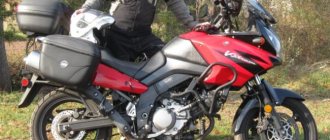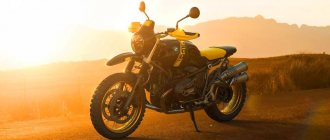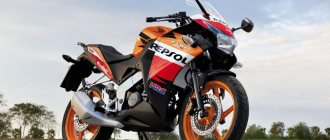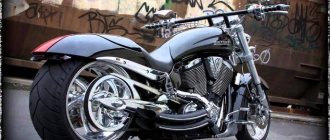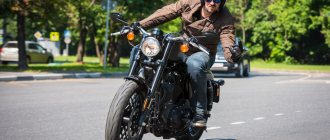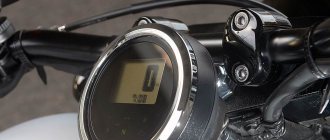BMW F800GT – TEST
Admission ticket
2013 onwards, 798 cm³, 90 l. pp., 213 kg (curb weight), from RUB 549,000.
text: Alexander Barkalov photo: Vladimir Levechev
in the photo: Alexander Barkalov
“For decades, the iconic models of the Bavarian concern BMW Motorrad have been the living embodiment of the class of touring machines for a huge number of motorcyclists . And it doesn’t matter so much whether we were talking about the GS family of all-terrain “rogues” or luxury tourers RT and GT - devices with a two-color propeller on the tank have always met the highest expectations of travel enthusiasts. However, a very impressive price even for models with basic equipment significantly reduced the flow of customers wishing to join the crowd of owners of premium brand motorcycles. Who knows, maybe the F800GT will be the key that will open the door to the world of BMW touring motorcycles, previously inaccessible to most consumers!
Relatives The presentation of the new BMW touring model took place at the EICMA international motorcycle show last year, but even the most notorious marketer, who has long lost the remnants of his conscience, would not dare to call the F800GT a motorcycle created from a “clean slate”. By and large, the Bavarian new product is the successor to the budget model F800ST, which was born in 2006. The lion's share of well-proven components and assemblies migrated from ST to GT, including the two-cylinder in-line engine. The proven and more than once proven reliability of the 798 cc liquid-cooled twin, also installed by the company on many other models, had undergone only minor changes by the time it was “implanted” into the F800GT chassis. In technical terms, the engine remained the same, but different injection maps allowed German engineers to slightly increase the peak power and torque figures. Compared to the F800ST, the engine power of the GT modification increased by 5 “horses” and reached the 90-horsepower mark, demonstrated at 8000 rpm. The two-cylinder engine produces a peak torque of 86 Nm at 5800 rpm, which allows for fairly dynamic acceleration in the widest speed range.
Naturally, you shouldn’t expect the excitement of an inline-four from a parallel twin: acceleration stops, and the engine begins to noticeably run out of steam as the tachometer needle approaches the red zone. Unfortunately, even the modified engine could not get rid of its signature feature in the form of vibrations that arise at high speeds. However, tremor is not a serious drawback, because it is unlikely that anyone in their right mind would think of pushing the tachometer needle “to the cutoff” after covering an 800-kilometer stretch. It is pleasant to note that a small increase in power and torque, although they could not radically change the character of the power unit, definitely made its operation more delicate, eliminating strain when driving at high speed.
Gran Turismo The GT prefix that appears in the name of the model categorically states that from a city motorcycle, the F800 has retrained, albeit a small one, but a conqueror of space, capable of covering thousands of kilometers in search of vivid impressions. To meet the new challenges, BMW engineers had to significantly modify both the plastic lining of the motorcycle and its ergonomics, as well as work some magic on the chassis. But first things first. As befits a “tourist,” the front fairing of the BMW F800GT has become much more massive: the plastic “nose” has expanded not only in width, but also noticeably stretched upward, giving the car a finished look. The windshield, although not adjustable, has also grown in all directions. Experience has shown that the dimensions and shape of the front fairing of the F800GT should be considered almost ideal for a driver of average height. In almost all speed modes, the plastic linings coped with the task perfectly, reliably diverting the flow of incoming air.
BMW also worked on the ergonomics of the driver's seat. And, despite the fact that the changes made at first glance are not so dramatic, sitting behind the wheel of the GT is noticeably more comfortable than the F800ST. Thanks to the fact that the steering wheel was raised by 20 mm and moved closer to the driver, and the shape of the gas tank was completely changed, there was noticeably more space for the pilot. Moreover, even drivers whose height is above average will not experience a particular shortage of free space. To make the rider's legs less tired, the footpegs were moved one and a half centimeters forward and down, and the seat was made wider and installed lower than on the ST version. Other changes affected the motorcycle's suspension. First of all, the fork travel was reduced by one and a half centimeters, which was done to increase control accuracy. On the other hand, the “nimbleness” of the device was sacrificed for stability at high speeds: the rear suspension pendulum was lengthened by 50 mm, which increased the wheelbase to an impressive 1514 mm. However, these are only theoretical calculations based on dry numbers - in fact, the motorcycle’s handling remained approximately at the level of the F800ST model. Even a fairly decent 213 kg of curb weight does not prevent the device from easily and comfortably passing the sharpest turns at decent speeds. It is worth saying that the Electronic Suspension Assist electronics package is installed as an option on the F800GT, which allows you to adjust the rear suspension on the go in three main positions: Comfort, Normal and Sport. To be honest, during everyday use, switching between modes, I didn’t feel much difference in the behavior of the motorcycle. Significant differences between the “comfortable” and “sporty” monoshock settings were revealed only on the go-kart track.
The road The developers conceived the BMW F800GT as a touring motorcycle, so the only sure way to unlock its full potential was to travel and, if possible, travel further. It was decided to test the new BMW on the road to the capital of Lithuania, Vilnius. Almost 1000 km of travel to the largest city of the Republic of Lithuania gave a clear understanding of the capabilities of the new product of the Bavarian concern. For testing, I got an F800GT, equipped with a set of branded cases - two side cases with a total volume of 55 liters and a central one with a capacity of 28 liters. Although hard side bags do not amaze with their dimensionless internal space, they can accommodate quite a lot of luggage.
True, comfortable urban operation of a motorcycle with such an additional weight seems to be an unfeasible task. The fact is that the dimensions of the side cases significantly exceed the width of the motorcycle handlebar, which often forces you to find yourself in an unpleasant situation when, moving between the rows, you risk hitting neighboring cars. In addition, the presence of panniers is noticeably felt when driving at high speeds and especially when “warming up” with oncoming traffic. In such cases, the additional luggage equipment begins to actively resist the oncoming air flow, unloading the front wheel and at the same time playfully wagging the rear of the motorcycle... However, after several tens of kilometers of travel you get used to this feature, and the slight “bumpiness” is no longer very distracting.
You gain even more confidence in the motorcycle on wet roads. As an option, the GT is equipped with ASC traction control, the need for which many may consider unnecessary due to the relatively modest engine power. I am inclined to say that the extra money paid for the electronic “lotion” will pay off more than once on a long journey, where wet asphalt, bitumen stains and sand in corners are far from rare phenomena. Speaking of electronic assistants, do not forget about ABS, which is included in the basic package of the F800GT. In general, the braking system, consisting of two 320 mm discs and 4-piston Brembo calipers on the front wheel and a 265 mm disc and 1-piston caliper on the rear, copes well with the tasks, with excellent feedback and information content. The only factor that bothered me even before the start of the journey was the small fuel tank. Agree, 15 liters is not the amount of fuel reserve that you would expect to see on a touring motorcycle. However, doubts about the capabilities of the motorcycle were dispelled at the very first gas station, as soon as I took out the gas nozzle and looked at the gas station display. It turns out that, having traveled almost 200 km, the motorcycle barely used up half of its fuel reserve! A more accurate calculation of fuel consumption showed that at an average speed of about 120 km/h, the F800GT engine consumes approximately 4.2 liters of fuel. It turns out that the device is capable of covering 360 km on one tank, which saves a lot of time by reducing the number of refueling stops. If the speed is increased to 140–160 km/h, fuel consumption will increase by about a liter, which is also very acceptable.
Summing up the results of the test, I would like to say that in general the BMW F800GT is perceived as a really good touring motorcycle, perfect for both short weekend outings and serious European long-distance trips. In addition, the F800GT is a comfortable and very practical device for every day, perfect for use in a metropolis. For many, the Bavarian novelty can be just a step on the way to a large BMW touring motorcycle, or it can live in the garage for a long time, flawlessly performing daily transport tasks and sharing the joy of traveling together. Perhaps the main disadvantage of the model is its high cost. In the version with a very useful, but expensive complete “minced meat”, the price of the motorcycle exceeds 600,000 rubles! But is this so much for an entrance ticket to the world of real premium “tourists”?
Specifications
Technical characteristics of BMW F800GT:
| Model | BMW F800GT |
| Motorcycle type | sports-tourist |
| Year of issue | 2013- |
| Frame | aluminum (bridge type, engine - load-bearing part) |
| engine's type | 2-cylinder 4-stroke in-line |
| Working volume | 798 cc |
| Bore x Stroke | 82x75.6 mm |
| Compression ratio | 12.0:1 |
| Cooling | liquid |
| Number of valves | DOHC, 4 valves per cylinder |
| Fuel supply system | injector |
| Ignition type | digital |
| Maximum power | 90 hp at 8000 rpm |
| Maximum torque | 86 Nm at 5800 rpm |
| Transmission | 6-speed |
| type of drive | belt |
| Front tire size | 120/70 ZR 17 |
| Rear tire size | 180/55 ZR 17 |
| Front brakes | 2 discs, 320 mm, 4-piston calipers (ABS) |
| Rear brakes | 1 disc, 265 mm, 1-piston caliper (ABS) |
| Front suspension | 43 mm telescopic fork, travel - 125 mm |
| Rear suspension | pendulum with monoshock absorber (adjustable preload and rebound), stroke - 125 mm |
| Overall dimensions (LxWxH) | 2156x905x1248 mm |
| Seat height | 800 mm (820 mm - comfortable saddle, 765 mm - low saddle) |
| Gas tank capacity | 15 l |
| Maximum speed | 200+ km/h |
| Acceleration to 100 km/h (0-100) | 3.7 sec |
| Motorcycle weight (curb) | 213 kg |

